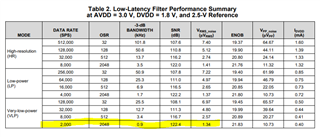Hi Gent.,
Happy Christmas Holiday!
May I know how to get the 1.34 µVRMS of input-referred noise in ADS127L01 d/s? thanks.
best regards,
Steven
This thread has been locked.
If you have a related question, please click the "Ask a related question" button in the top right corner. The newly created question will be automatically linked to this question.
Hi Gent.,
Happy Christmas Holiday!
May I know how to get the 1.34 µVRMS of input-referred noise in ADS127L01 d/s? thanks.
best regards,
Steven
Thanks Dale,
Hi Steven,
The 1.34uVrms noise is a combination of input clock frequency, filter type and OSR setting. The clock frequency applied to the CLK, pin 24, should be adjusted to 4.096MHz.
CLK(pin24)=4.096MHz
OSR=2048: OSR1(pin15)=1=DVDD, OSR0(pin16)=1=DVDD
Low-latency filter (LL): FILTER1(pin12)=1=DVDD, FILTER0(pin13)=0=DGND
LP,VLP mode: HR(pin29)=0=DGND
Since you are operating at a lower clock frequency, you can further reduce power by adjusting REXT(pin7) to 120kOhm(VLP mode), but this is not necessary.
Please note that in order to reduce the input noise to 1.34uVrms, you are reducing the data rate to 2000sps, and the resulting input signal bandwidth is 900Hz.

Regards,
Keith Nicholas
Precision ADC Applications
Thank Keith for detailed explanation.
btw, how to get this 1.34uV rms, by calculation or simulation or measurement / test in lab?
thanks.
Steven
Hi Steven,
These numbers were measured in the lab by shorting the inputs (0V input) and recording a large number of ADC conversion readings (16k), and then calculating the 1-sigma value of the data set.
Many of the newer EVM's provide this calculation in the Histogram section, but unfortunately, the EVM for the ADS127L01 does not provide this capability. However, if you have the EVM, you can collect the sample set, export to Excel, and then calculate the 1-sigma value of the dataset using Excel or another similar spreadsheet tool.
Regards,
Keith